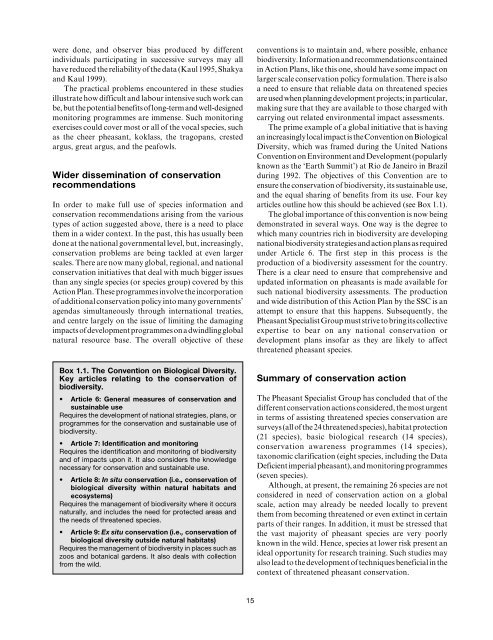Pheasants: Status Survey and Conservation Action Plan ... - IUCN
Pheasants: Status Survey and Conservation Action Plan ... - IUCN
Pheasants: Status Survey and Conservation Action Plan ... - IUCN
Create successful ePaper yourself
Turn your PDF publications into a flip-book with our unique Google optimized e-Paper software.
were done, <strong>and</strong> observer bias produced by different<br />
individuals participating in successive surveys may all<br />
have reduced the reliability of the data (Kaul 1995, Shakya<br />
<strong>and</strong> Kaul 1999).<br />
The practical problems encountered in these studies<br />
illustrate how difficult <strong>and</strong> labour intensive such work can<br />
be, but the potential benefits of long-term <strong>and</strong> well-designed<br />
monitoring programmes are immense. Such monitoring<br />
exercises could cover most or all of the vocal species, such<br />
as the cheer pheasant, koklass, the tragopans, crested<br />
argus, great argus, <strong>and</strong> the peafowls.<br />
Wider dissemination of conservation<br />
recommendations<br />
In order to make full use of species information <strong>and</strong><br />
conservation recommendations arising from the various<br />
types of action suggested above, there is a need to place<br />
them in a wider context. In the past, this has usually been<br />
done at the national governmental level, but, increasingly,<br />
conservation problems are being tackled at even larger<br />
scales. There are now many global, regional, <strong>and</strong> national<br />
conservation initiatives that deal with much bigger issues<br />
than any single species (or species group) covered by this<br />
<strong>Action</strong> <strong>Plan</strong>. These programmes involve the incorporation<br />
of additional conservation policy into many governments’<br />
agendas simultaneously through international treaties,<br />
<strong>and</strong> centre largely on the issue of limiting the damaging<br />
impacts of development programmes on a dwindling global<br />
natural resource base. The overall objective of these<br />
Box 1.1. The Convention on Biological Diversity.<br />
Key articles relating to the conservation of<br />
biodiversity.<br />
• Article 6: General measures of conservation <strong>and</strong><br />
sustainable use<br />
Requires the development of national strategies, plans, or<br />
programmes for the conservation <strong>and</strong> sustainable use of<br />
biodiversity.<br />
• Article 7: Identification <strong>and</strong> monitoring<br />
Requires the identification <strong>and</strong> monitoring of biodiversity<br />
<strong>and</strong> of impacts upon it. It also considers the knowledge<br />
necessary for conservation <strong>and</strong> sustainable use.<br />
• Article 8: In situ conservation (i.e., conservation of<br />
biological diversity within natural habitats <strong>and</strong><br />
ecosystems)<br />
Requires the management of biodiversity where it occurs<br />
naturally, <strong>and</strong> includes the need for protected areas <strong>and</strong><br />
the needs of threatened species.<br />
• Article 9: Ex situ conservation (i.e., conservation of<br />
biological diversity outside natural habitats)<br />
Requires the management of biodiversity in places such as<br />
zoos <strong>and</strong> botanical gardens. It also deals with collection<br />
from the wild.<br />
conventions is to maintain <strong>and</strong>, where possible, enhance<br />
biodiversity. Information <strong>and</strong> recommendations contained<br />
in <strong>Action</strong> <strong>Plan</strong>s, like this one, should have some impact on<br />
larger scale conservation policy formulation. There is also<br />
a need to ensure that reliable data on threatened species<br />
are used when planning development projects; in particular,<br />
making sure that they are available to those charged with<br />
carrying out related environmental impact assessments.<br />
The prime example of a global initiative that is having<br />
an increasingly local impact is the Convention on Biological<br />
Diversity, which was framed during the United Nations<br />
Convention on Environment <strong>and</strong> Development (popularly<br />
known as the ‘Earth Summit’) at Rio de Janeiro in Brazil<br />
during 1992. The objectives of this Convention are to<br />
ensure the conservation of biodiversity, its sustainable use,<br />
<strong>and</strong> the equal sharing of benefits from its use. Four key<br />
articles outline how this should be achieved (see Box 1.1).<br />
The global importance of this convention is now being<br />
demonstrated in several ways. One way is the degree to<br />
which many countries rich in biodiversity are developing<br />
national biodiversity strategies <strong>and</strong> action plans as required<br />
under Article 6. The first step in this process is the<br />
production of a biodiversity assessment for the country.<br />
There is a clear need to ensure that comprehensive <strong>and</strong><br />
updated information on pheasants is made available for<br />
such national biodiversity assessments. The production<br />
<strong>and</strong> wide distribution of this <strong>Action</strong> <strong>Plan</strong> by the SSC is an<br />
attempt to ensure that this happens. Subsequently, the<br />
Pheasant Specialist Group must strive to bring its collective<br />
expertise to bear on any national conservation or<br />
development plans insofar as they are likely to affect<br />
threatened pheasant species.<br />
Summary of conservation action<br />
The Pheasant Specialist Group has concluded that of the<br />
different conservation actions considered, the most urgent<br />
in terms of assisting threatened species conservation are<br />
surveys (all of the 24 threatened species), habitat protection<br />
(21 species), basic biological research (14 species),<br />
conservation awareness programmes (14 species),<br />
taxonomic clarification (eight species, including the Data<br />
Deficient imperial pheasant), <strong>and</strong> monitoring programmes<br />
(seven species).<br />
Although, at present, the remaining 26 species are not<br />
considered in need of conservation action on a global<br />
scale, action may already be needed locally to prevent<br />
them from becoming threatened or even extinct in certain<br />
parts of their ranges. In addition, it must be stressed that<br />
the vast majority of pheasant species are very poorly<br />
known in the wild. Hence, species at lower risk present an<br />
ideal opportunity for research training. Such studies may<br />
also lead to the development of techniques beneficial in the<br />
context of threatened pheasant conservation.<br />
15
















